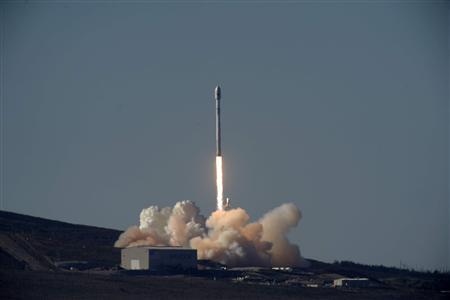
An unmanned Falcon 9 rocket blasted off from California on Sunday to test upgrades before commercial satellite launch services begin later this year.
The 22-story rocket, built and flown by Space Exploration Technologies, or SpaceX, soared off a newly refurbished, leased launch pad at Vandenberg Air Force Station at noon (1600 GMT).
An unmanned Falcon 9 rocket blasted off from California on Sunday to test upgrades before commercial satellite launch services begin later this year.
 The 22-story rocket, built and flown by Space Exploration Technologies, or SpaceX, soared off a newly refurbished, leased launch pad at Vandenberg Air Force Station at noon (1600 GMT).
The 22-story rocket, built and flown by Space Exploration Technologies, or SpaceX, soared off a newly refurbished, leased launch pad at Vandenberg Air Force Station at noon (1600 GMT).
The Falcon 9 blazed through clear blue skies out over the Pacific Ocean, its water vapor trail visible even as the rocket left the atmosphere.
"It went better than expected. It was incredibly smooth," SpaceX founder and Chief Executive Elon Musk told Reuters after the launch.
Nestled inside the rocket's new 17-foot (5-meter) diameter nose cone was a small Canadian science satellite called Cassiope that initially was to fly on SpaceX's now-discontinued Falcon 1 launcher in 2008.
"It's certainly a huge relief to have successfully delivered Cassiope to orbit. It's been weighing on me quite heavily," Musk said.
Cassiope, which is designed to monitor the space environment around Earth and serve as a communications satellite, and five secondary payloads were delivered into their intended orbits, Musk told reporters on a conference call.
As an experiment, both of the rocket's two stages were restarted during flight.
Musk is particularly interested in developing the technology to fly the Falcon's first stage back to the launch site or have it gently splash down in the water so its motors can be recovered, refurbished and reflown. Currently, after delivering their payloads into orbit, the boosters tumble back toward Earth and essentially explode mid-air before crashing into the sea.
"The most revolutionary thing about the new Falcon 9 is the potential ability to recover the boost phase, which is almost three-quarters of the cost of the rocket," Musk said.
Neither engine restart test went perfectly, but engineers were able to get enough data to plan on a demonstration flight next year.
"The most important thing is we now believe we have all the pieces of the puzzle," Musk said.
The upgraded Falcon 9 v1.1 has engines that are 60 percent more powerful than previous versions, longer fuel tanks, new avionics and software and other features intended to boost lift capacity and simplify operations for commercial service.
Privately-owned SpaceX has contracts for more than 50 launches of its new Falcon 9 and planned Falcon Heavy rockets.
Ten of those missions are to fly cargo to the International Space Station for NASA. The other customers are non-U.S. government agencies and commercial satellite operators.
SpaceX also has two contracts for small U.S. Air Force satellites but is looking to break the monopoly that United Launch Alliance, a partnership of Lockheed Martin and Boeing, has on flying big military satellites as well.
SpaceX already has flown three Dragon capsules to the station and made two other successful test flights with its older version Falcons.
Falcon 9's next mission is to put a communications satellite into orbit for SES World Skies. The launch is targeted for next month from Cape Canaveral Air Force Station in Florida.
"We accomplished a lot today," Musk said. "We have a little bit of work to do obviously, but all-in-all I think it's been a great day."
(Editing by Paul Simao)

 Previous page
Previous page Back to top
Back to top







